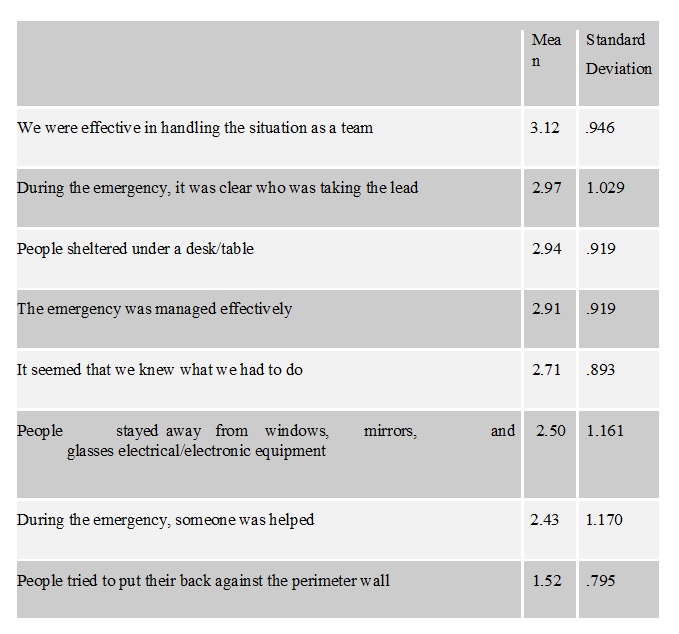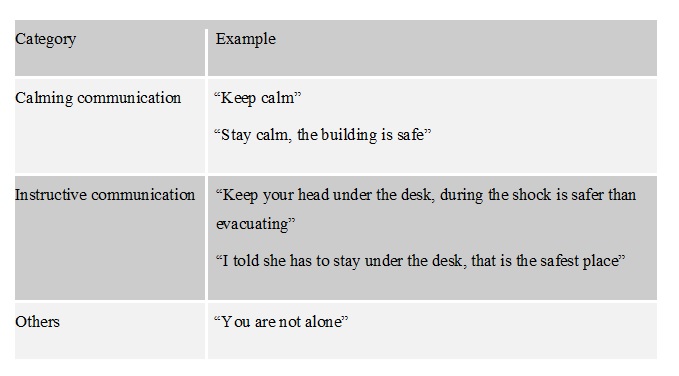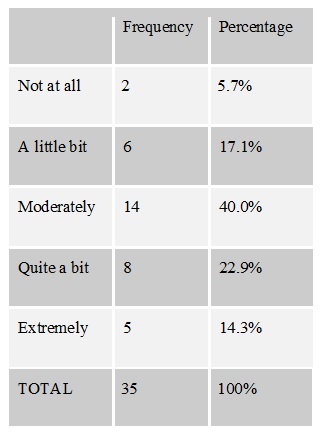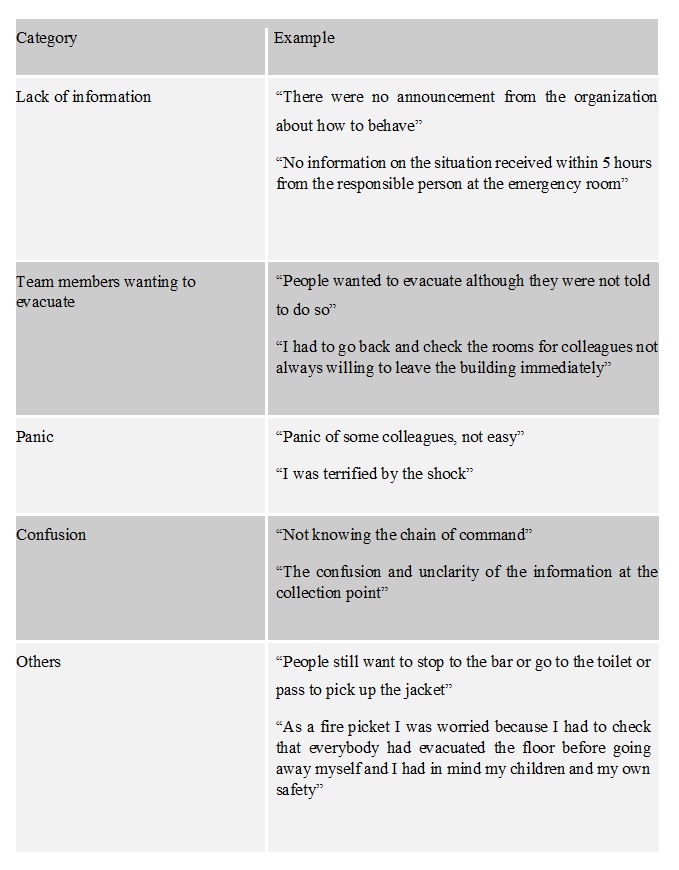Emergency and evacuation response
Emergency and evacuation response
Immediate action during the shock
Table 4 presents the respondents’ immediate actions performed during the shock. Most of them reported actions that can be categorized as Action Tasks according to Galea and colleagues (2010): sheltering under the desk, wait, stay calm, etc. Others reported Information Tasks (Galea et al., 2010): advise people to wait, informed colleagues to go under the desk, call 100 to receive further information, looking at colleagues, etc. Answers have been grouped into categories (Table 4).
Table 4
What Were your Immediate Actions during the Shock?

Team emergency response
Table 5 presents the opinions on the team’s emergency preparedness from the leaders’ perspective as a mean score with 1 being totally disagree and 4 being totally agree. The statements are presented in the order of those in which respondents reported higher levels of agreement to lower levels of agreements.
Table 5
Team Emergency Response

Note. Values are based on a scale of 1 to 4 with 1 = totally disagree and 4 = totally agree.
From the table above we can make some observations. Generally, having a look to the means corresponding to each item, it is clear that respondents had a positive perception about the evacuation process (“The emergency was managed effectively” M=2.91). The item that received the higher score is the only one regarding team behavior (M=3.12).
Interpersonal communication with the team members
We also wanted to investigate some aspects of the communication between leaders and teams’ members. So we asked people if they have encouraged someone to stay calm and what they have told him/her. 46% of the sample has actually encouraged some of the members.
Table 6 reports the categories we used to group the answers.
Table 6
Encouraging communication

We were interested in examining also the communication between leaders and members who didn’t want to leave the building. First of all we asked if there was the necessity to convince people to evacuate. 23% of the participants reported that they have to convince some occupants to the need to leave. This percentage is not so high, meaning that three on four employees were already aware of the procedure to follow. Then we asked this portion of participants to report what they told to convince to evacuate (see Table 8).
Table 8
Convincing to leave

Evacuation
As shown in Table 6, most of the respondents (59.5%) evacuated, while 40.5% remained in the building.
Table 6
Did you Evacuate during the Seismic Shock?

Team evacuation behavior (n=12)
Table 12 presents team evacuation behavior as a mean score with 1 being totally disagree and 4 being totally agree. The statements are presented in the order of those in which respondents reported higher levels of agreement to lower levels of agreements.
Table 7
Team Evacuation Behavior

Note. Values are based on a scale of 1 to 4 with 1 = totallydisagree and 4 = totally agree.
Table 12 shows that the evacuation process was performed successfully. Indeed, the higher scores regard behavioral indicators of an efficient evacuation process. Means for these items were all higher than 2.5 on 4. Between the behavioral indicators of a not efficient evacuation only “Someone underestimated the danger” has a mean over 2 on 4 (M=2.27), which means that some leaders were “Partially agree” or “Totally agree” with this statement.
Something interesting to notice is that nobody put a score under “Partially agree” for the item “people used emergency exits” and for “everybody were able to use safely the escape routes” and nobody answered “Totally disagree” for “people evacuated orderly” and “people escape to a place of total safety in a reasonable time”. On the other hand, nobody was “Totally agree” with the item “before moving forward people tested the floor with the foot” and “when moving people kept the body flat to the wall”. This is to say that all the participants were relatively unanimous about the statements we proposed.
Situation’s degree of threat
We asked the respondents to rate the personal degree of threat of the emergency situation. As shown in Table 8, most of them (40%) reported a moderated degree of threat, while 22.9% answered “Quite a bit”.
Table 8
How Did you Rate the Degree of Threat of the Situation?

Difficulties in leading the situation
We asked the respondents to report if they had experienced some difficulties in leading the emergency situation. Most of them (38.9%) reported to have had only “A little bit” of difficulties in leading the situation, while 33.3% reported to not have had any difficulties (see table 9).
Table 9
Did you Encounter any Difficulties in Leading the Situation?

Type of difficulties in leading the situation
Table 10 presents different type of difficulties in leading the situation reported by the respondents through an open-ended question. We have categorized them in 4 groups: lack of information, team member wanting to evacuate, panic and confusion.
Table 10
Difficulties Met in Leading the Situation

Self-confidence in leading the situation
We asked the respondents to give a number between 0 and 100 to rate their level of selfconfidence in leading the emergency situation. The mean was 67.87 (SD= 24.04), so they reported a good level of self-confidence.
© – MANAGEMENT OF AN EMERGENCY EVACUATION: A LEADER’S PERSPECTIVE – Sara Colangeli


